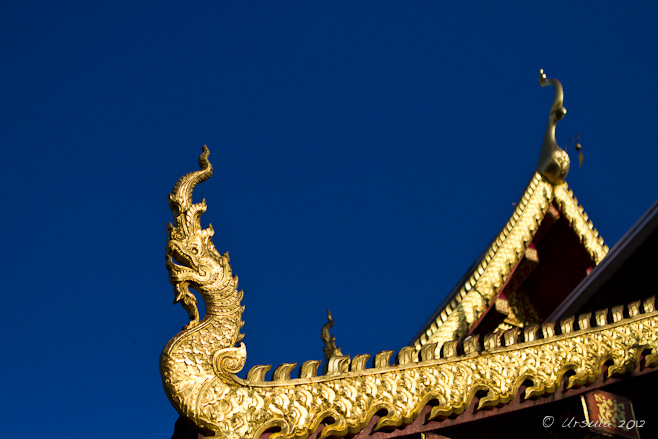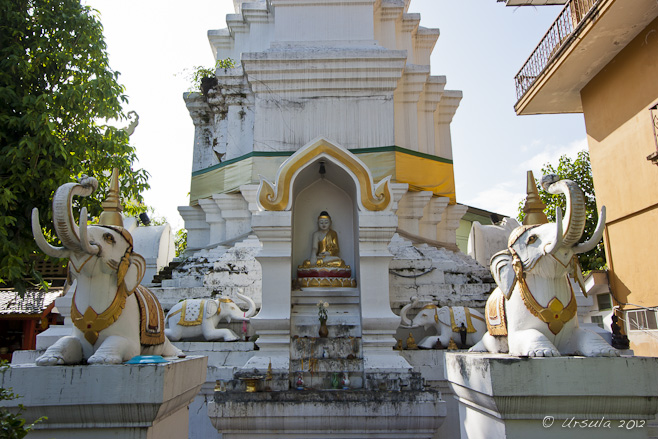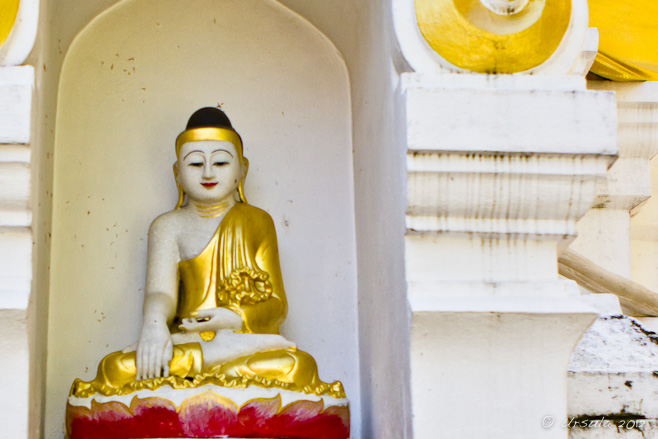
The chofah ("light tassel") is a common element in most temples throughout Thailand and the neighbouring region.
Last October, we were heading off on a much-anticipated short trip to Thailand’s North. Ask any Thai about the northern cities of Chiang Rai and Chiang Mai, and they will tell you that they are: “very beautiful! There are many temples.” A non-Thai friend of ours in Bangkok asked what we would see at our first stop: Chiang Rai. “Temples!” I replied with a wink, knowing the groan that my comment would be met with.
A lot of non-Thais, even those who have lived in the country a long time, think that temples are all the same. They are not.
Of course, temples, which essentially comprise a collection of buildings for religious ceremonies, study and worship, have common elements. But, as with anything else, the more you look, the more you notice.
We had plenty of opportunity to notice the small – and larger – differences between temples as we walked around Chiang Rai, visiting five complexes on foot, and another by car (Wat Rong Khun, which I’ve talked about before), essentially in the space of a day. This little provincial city has the odd church and mosque as well, but it is the Buddhist temples on every corner that stand out.
Our first stop was at the 750-year-old Wat Ming Muang. During the reign of King Mengrai The Great when the temple was constructed, there was a significant Burmese (Shan/Tai Yai) population in this area – hence the Burmese influence in the architecture and sculptures.

Every temple has a chedi (stupa or pagoda) which houses relics from the Buddha. This one, at Wat Ming Muang, features classic white elephants.

Burmese-style Buddha image ~ Wat Ming Muang
Like any temple, especially an old one, Wat Ming Muang (The Auspicious Temple of the City) is continually expanding and undergoing renovation. I find it fascinating to watch how the back-bones of the elements are constructed, before they become the ornately finished products we are used to seeing.

This finely-detailed elephant head with its jewelled naga-like crown is one of a pair, adorning the new stairway.

The new cement columns at Wat Ming Muang feature a different style of elephant.
Our second stop was at Wat Phra Kaew (Temple of the Emerald Buddha), which was named for the the green gemstone (jade rather than emerald) buddha image which was found there when lightning struck the chedi and cracked it open in 1434. That Emerald Buddha is now in the Grand Palace in Bangkok where, amid great ceremony, the King changes it’s golden coat three times a year to mark the formal change of seasons.

The replacement buddha ~ Wat Phra Kaew
The replacement Chiang Rai Buddha is not an exact copy, but a ‘replica’ commissioned in 1991 to honor the Princess Mother’s 90th birthday. It was carved in Beijing from Canadian jadeite donated by a rich Chinese businessman.

Jade Buddha Head ~ Wat Phra Kaew

Altar in the grounds of Wat Phra Kaew, dedicated to Phra Sangkajai (Maha Katyayana), one of the "Ten Disciples of the Buddha".

Classic gold Buddha under natural and artificial light, flanked by "Tung Kradang"; banners carved with religious stories and commissioned as offerings to the Lord Buddha. ~ Wat Phra Kaew

Burmese Buddha ~ Wat Phra Kaew Museum

Light from the carved teak window balusters in the Wat Phra Kaew Museum fall on a Bodhisattva.

Tiers of old carved Buddha images ~ Wat Phra Kaew Museum

Ganesha, Remover of Obstacles ~ Wat Phra Kaew Museum

Budai, the "Laughing Buddha", rides a Chinese dragon ~ Wat Phra Kaew Museum.

In the reading corner, two "nehn", or novice monks, take time out.
From Wat Phra Kaew, it was a short walk to our lodgings, via two more local temples: Wat Phra Singh and Wat Klang Wiang.

Buddha ~ Wat Phra Singh

Visiting monk. His red-ink tattoos are common among Burmese (Shan / Tai) men. The designs are stamped before being tattooed, and last about five years, protecting the wearer against evil spirits, bringing strength, and resisting and curing diseases.

It's always good to know you are in a "No Killing Area"! Wat Klang Wiang

Afternoon clean-up duty ~ Wat Klang Wiang
The next morning, after our trip by car to The White Temple (Wat Rong Khun), we visited Wat Phra That Doi Chom Thong. The ancient sacred stone representing the city pillar; the “navel” or centre of the city; was moved here in 1992. Unlike most Thai cities, which house their city pillars, their Lak Mueang, in a shrine, Chiang Rai displays its pillar in an open area. I leave it to you – but I don’t think they look like navels!

Sadu Mueang, the Navel or Omphalos of the City, Doi Chom Thong, Chiang Rai

Yup. "Navals." Indeed.

Small figures of elephants and horses are common elements in Thai shrines. Wat Phrathat Doi Jom Thong

More Buddhas - different Buddhas. Wat Phrathat Doi Jom Thong

Whatever the religious image, Thais are always ready to "pay their respects" and to pray. Wat Phrathat Doi Jom Thong
 Yes, there is a temple on every corner in Chiang Rai, and they are all lovely.
Yes, there is a temple on every corner in Chiang Rai, and they are all lovely.
To my mind, at least, they are also all very different!
Photos: 28-29 October 2011.



























.png)


I love the artwork/carvings in these temples… similar yet unique and of course they have elephants – a favorite of mine.
Welcome back! Yes, we too love the elephants. 🙂
Ursula, ich liebe diese Serie mit den Buddhas und Elefanten.
Auch geben die Fotos die sfeer wieder, Grüsse Dietmut
Thanks, Dietmut. I’m so glad you liked the post. Herzlichen Glückwunsch!
Ursula, ich liebe diese Serie. Schön die Tempel, Buddhas en elefanten en natürlich geben auch die anderen Fotos eine besondere Stimmung wieder. Grüsse Dietmut